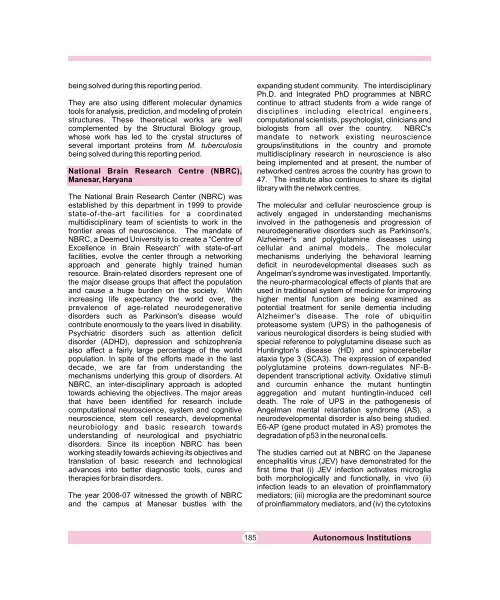ANNUAL REPORT - Department of Biotechnology
ANNUAL REPORT - Department of Biotechnology
ANNUAL REPORT - Department of Biotechnology
Create successful ePaper yourself
Turn your PDF publications into a flip-book with our unique Google optimized e-Paper software.
eing solved during this reporting period.<br />
They are also using different molecular dynamics<br />
tools for analysis, prediction, and modeling <strong>of</strong> protein<br />
structures. These theoretical works are well<br />
complemented by the Structural Biology group,<br />
whose work has led to the crystal structures <strong>of</strong><br />
several important proteins from M. tuberculosis<br />
being solved during this reporting period.<br />
National Brain Research Centre (NBRC),<br />
Manesar, Haryana<br />
The National Brain Research Center (NBRC) was<br />
established by this department in 1999 to provide<br />
state-<strong>of</strong>-the-art facilities for a coordinated<br />
multidisciplinary team <strong>of</strong> scientists to work in the<br />
frontier areas <strong>of</strong> neuroscience. The mandate <strong>of</strong><br />
NBRC, a Deemed University is to create a “Centre <strong>of</strong><br />
Excellence in Brain Research” with state-<strong>of</strong>-art<br />
facilities, evolve the center through a networking<br />
approach and generate highly trained human<br />
resource. Brain-related disorders represent one <strong>of</strong><br />
the major disease groups that affect the population<br />
and cause a huge burden on the society. With<br />
increasing life expectancy the world over, the<br />
prevalence <strong>of</strong> age-related neurodegenerative<br />
disorders such as Parkinson's disease would<br />
contribute enormously to the years lived in disability.<br />
Psychiatric disorders such as attention deficit<br />
disorder (ADHD), depression and schizophrenia<br />
also affect a fairly large percentage <strong>of</strong> the world<br />
population. In spite <strong>of</strong> the efforts made in the last<br />
decade, we are far from understanding the<br />
mechanisms underlying this group <strong>of</strong> disorders. At<br />
NBRC, an inter-disciplinary approach is adopted<br />
towards achieving the objectives. The major areas<br />
that have been identified for research include<br />
computational neuroscience, system and cognitive<br />
neuroscience, stem cell research, developmental<br />
neurobiology and basic research towards<br />
understanding <strong>of</strong> neurological and psychiatric<br />
disorders. Since its inception NBRC has been<br />
working steadily towards achieving its objectives and<br />
translation <strong>of</strong> basic research and technological<br />
advances into better diagnostic tools, cures and<br />
therapies for brain disorders.<br />
The year 2006-07 witnessed the growth <strong>of</strong> NBRC<br />
and the campus at Manesar bustles with the<br />
expanding student community. The interdisciplinary<br />
Ph.D. and Integrated PhD programmes at NBRC<br />
continue to attract students from a wide range <strong>of</strong><br />
disciplines including electrical engineers,<br />
computational scientists, psychologist, clinicians and<br />
biologists from all over the country. NBRC's<br />
mandate to network existing neuroscience<br />
groups/institutions in the country and promote<br />
multidisciplinary research in neuroscience is also<br />
being implemented and at present, the number <strong>of</strong><br />
networked centres across the country has grown to<br />
47. The institute also continues to share its digital<br />
library with the network centres.<br />
The molecular and cellular neuroscience group is<br />
actively engaged in understanding mechanisms<br />
involved in the pathogenesis and progression <strong>of</strong><br />
neurodegenerative disorders such as Parkinson's,<br />
Alzheimer's and polyglutamine diseases using<br />
cellular and animal models,. The molecular<br />
mechanisms underlying the behavioral learning<br />
deficit in neurodevelopmental diseases such as<br />
Angelman's syndrome was investigated. Importantly,<br />
the neuro-pharmacological effects <strong>of</strong> plants that are<br />
used in traditional system <strong>of</strong> medicine for improving<br />
higher mental function are being examined as<br />
potential treatment for senile dementia including<br />
Alzheimer's disease. The role <strong>of</strong> ubiquitin<br />
proteasome system (UPS) in the pathogenesis <strong>of</strong><br />
various neurological disorders is being studied with<br />
special reference to polyglutamine disease such as<br />
Huntington's disease (HD) and spinocerebellar<br />
ataxia type 3 (SCA3). The expression <strong>of</strong> expanded<br />
polyglutamine proteins down-regulates NF-Bdependent<br />
transcriptional activity. Oxidative stimuli<br />
and curcumin enhance the mutant huntingtin<br />
aggregation and mutant huntingtin-induced cell<br />
death. The role <strong>of</strong> UPS in the pathogenesis <strong>of</strong><br />
Angelman mental retardation syndrome (AS), a<br />
neurodevelopmental disorder is also being studied.<br />
E6-AP (gene product mutated in AS) promotes the<br />
degradation <strong>of</strong> p53 in the neuronal cells.<br />
The studies carried out at NBRC on the Japanese<br />
encephalitis virus (JEV) have demonstrated for the<br />
first time that (i) JEV infection activates microglia<br />
both morphologically and functionally, in vivo (ii)<br />
infection leads to an elevation <strong>of</strong> proinflammatory<br />
mediators; (iii) microglia are the predominant source<br />
<strong>of</strong> proinflammatory mediators, and (iv) the cytotoxins<br />
185 Autonomous Institutions

















